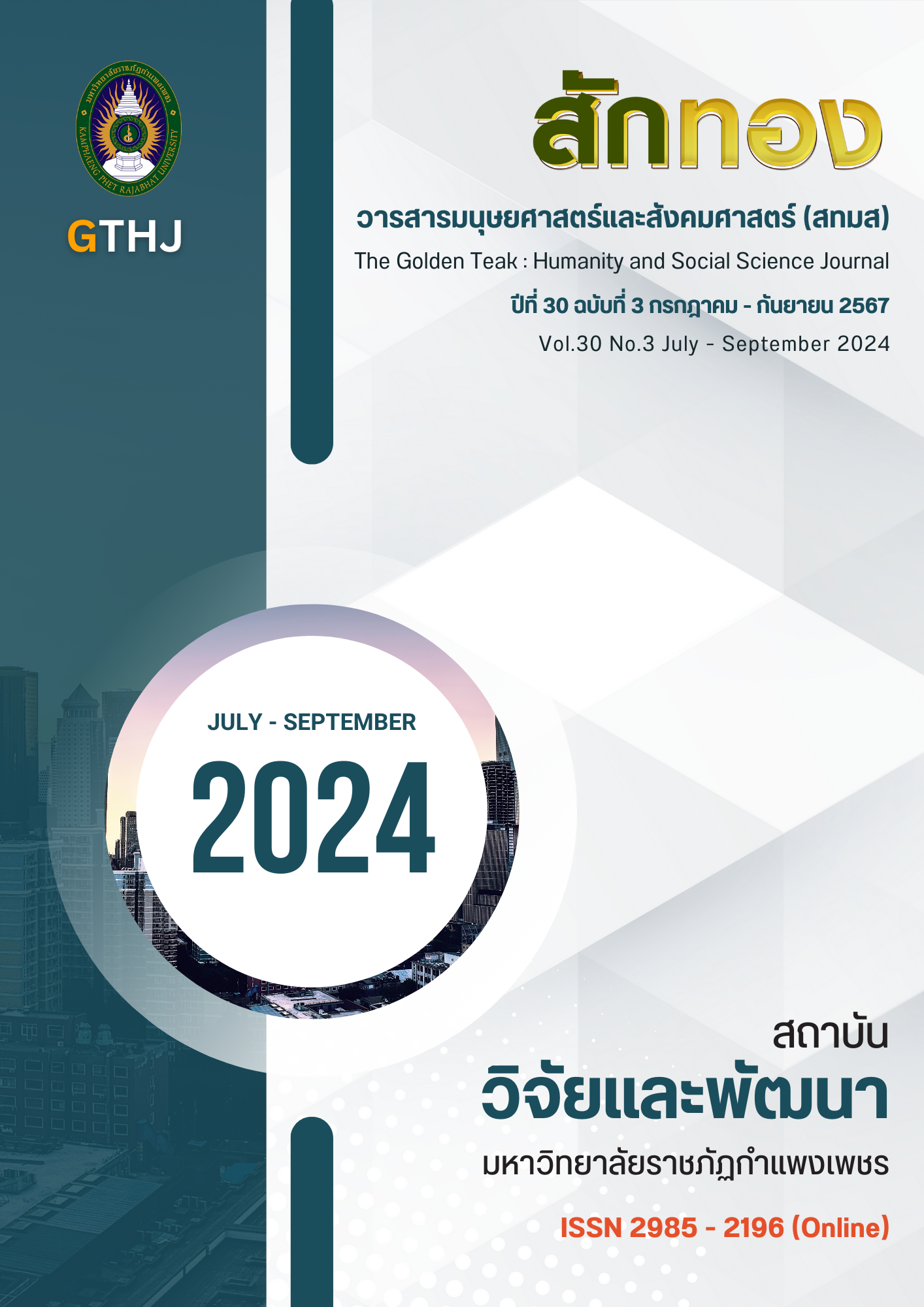Factors Influencing Employees’ Intention to Use Technology for Hybrid Office Working in the Electricity Generating Industry, Rayong Province
Main Article Content
Abstract
This research aimed to analyze the influences of performance expectancy, effort expectancy, social influence, facilitating conditions, hedonic motivation, price value, and habit on employees' intentions to use technology for hybrid offices. The sample consisted of 360 employees working in Rayong Province’s large-scale SPP electricity generating industry. The data were gathered using a self-administered questionnaire that had undergone validity and reliability testing. Descriptive and inferential statistics, including structural equation modeling (SEM), were used to analyze the data. The findings showed that performance expectancy, effort expectancy, social influence, facilitating conditions, and habit had a statistically significant influence on employees' intentions to use technology for hybrid office working.
Article Details

This work is licensed under a Creative Commons Attribution-NonCommercial-NoDerivatives 4.0 International License.
บทความที่ได้รับการตีพิมพ์เป็นลิขสิทธิ์ของวารสาร สักทอง : วารสารมนุษยศาสตร์และสังคมศาสตร์ สถาบันวิจัยและพัฒนา มหาวิทยาลับราชภัฏกำแพงเพชร
ข้อคิดเห็นใดๆ ที่ปรากฎในวารสารเป็นวรรณกรรมของผู้เขียนโดยเฉพาะ ซึ่งมหาวิทยาลัยราชภัฏกำแพงเพชรและบรรณาธิการไม่จำเป็นต้องเห็นด้วย
References
Aswani, R., Ilavarasan, P.V., Kar, A.K. & Vijayan, S. (2018). Adoption of public wifi using UTAUT2: An exploration in an emerging economy. Procedia Computer Science, 132, 297-306.
Benjathikul, B. (2021). Hybrid working: a brand new working standard for the future. Journal of MCU Buddhapanya, 6(3), 47-61. [In Thai]
Bick, A., Blandin, A. & Mertens, K. (2020). Work from home after the COVID-19 outbreak. Globalization Institute Working Paper, 390, 1-20.
Byrne, M. B. (2010). Structural equation modeling with AMOS : Basic concepts, application, and programming. (2 nd ed.). New York : Routledge.
Chuprapawan, Y. (2004). New Innovation Acceptance. Bangkok : Odeanstore. [In Thai]
Cronbach, L.J. (1951). Coefficient alpha and the internal structure of tests. Psychometrika, 16(3), 297-334.
Energy Regulatory Commission of Thailand. (2022). Energy Information Center. [Online]. Available : https://app03.erc.or.th/ERCSPP/ [2022, February 8]. [In Thai]
Faqih, K.M.S. & Jaradat, M-I.R. (2021). Integrating TTF and UTAUT2 theories to investigate the adoption of augmented reality technology in education: Perspective from a developing country. Technology in Society, 67, 1-16.
Fornell, C. & Larcker, D.F. (1981). Evaluating structural equation models with unobservable variables and measurement error. Journal of Marketing Research, 18(1), 39–50.
Hair Jr, J.F., Sarstedt, M., Hopkins, L. & Kuppelwieser, V.G. (2010). Partial Least Squares Structural Equation Modeling (PLS-SEM). European Business Review, 26(2), 106-121.
Hendl, T., Chung, R. & Wild, V. (2020). Pandemic Surveillance and Racialized Subpopulations: Mitigating Vulnerabilities in COVID-19 Apps. Bioethical Inquiry, 17(4), 829-834.
Joungtrakul, J. (2020). Human Resource Development : Theory and Practices. Bangkok : Se-Education. [In Thai]
Kaiyawan, Y. (2007). Research for Industrial Management. Bangkok : Bangkok Compliment Media Center. [In Thai]
Khan, I.U., Hameed, Z. & Khan, S.U. (2017). Understanding online banking adoption in a developing country: UTAUT2 with cultural moderators. Journal of Global Information Management, 25(1), 43-65.
Kline, R.B. (2005). Principles and Practice of Structural Equation Modeling. (2 nd ed.). New York : The Guilford Press.
Krungsri Research. (2022). Industry Outlook 2021-2023 : Power Generation. [Online]. Available : https://www.krungsri.com/en/ research/industry/industry-outlook/energy-utilities/power-generation/io/io-power-generation-21 [2022, February 8]. [In Thai]
Lee, S.W. (2019). Determinants of continuous intention on food delivery apps : Extending utaut2 with information quality. Sustainability, 11(11), 1-15.
McCloskey, D. & Bennett, G. (2020). Examining artificial intelligence acceptance: Exploring smart speaker adoption with the unified theory of acceptance and use of technology (UTAUT2). Pennsylvania Economic Review, 27(2), 44-70.
Merhi, M., Hone, K. & Tarhini, A. (2019). A cross-cultural study of the intention to use mobile banking between Lebanese and British consumers : Extending UTAUT2 with security, privacy and trust. Technology in Society, 59, 1-13.
Ministry of Industry. (2022). Factory Information. [Online]. Available : https://www.diw.go.th/ webdiw/s-data-fac/ [2022, February 8]. [In Thai]
Nikolopoulos, F. & Likothanassis, S. (2017). Using UTAUT2 for cloud computing technology acceptance modeling. MIS Quarterly, 27(3), 425-478.
Parker, L.D. (2020). The COVID-19 office in transition: cost, efficiency and the social responsibility business case. Accounting, Auditing and Accountability Journal, 33(8), 1-32.
Pasaribu, N.P. (2022). The Effect of the COVID-19 Pandemic and Utaut2 in Adopting Mobile Banking at Jakarta. Jurnal Manajemen (Edisi Elektronik), 13(1), 1-14.
Raines-Eudy, R. (2000). Using structural equation modeling to test for differential reliability and validity: An empirical demonstration. Structural Equation Modeling, 7, 124-141.
Raman, A. & Don, Y. (2013). Preservice teachers’ acceptance of learning management software: An application of the UTAUT2 model. International Education Studies, 6(7), 157-164.
Rerkkham, S. (2020). Strategic human resource procurement in a turning point. Bangkok : Chulalongkorn University. [In Thai]
Sangsawangwatthana, T. (2020). "New Normal" A new way of life and adaptation of Thai people after COVID-19: Work Education and Business. Journal of Local Governance and Innovation, 4(3), 371-386. [In Thai]
Venkatesh, V., Morris, M.G., Davis, G.B. & Davis, F.D. (2003). User acceptance of information technology: Toward a unified view. MIS Quarterly, 27(3), 425-478.
Venkatesh, V., Thong, J.Y.L. & Xu, X. (2012). Consumer acceptance and use of information technology : Extending the unified theory of acceptance and use of technology. MIS Quarterly, 36(1), 157-178.


